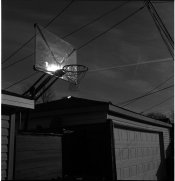markjwyatt
Subscriber
I think the lens is slightly newer than the camera body, by a couple of years, The Biotar is a sort after lens there's one on bay $930 at the moment pre-set Exacta mount unlike yours, it's uncoated as well with a pre-WWII serial number. I've noticed that lately more 58mm Biotars have been listed at reasonable BIN prices.
The names and markings changed, the Varex trade name was already registered in the US so US imports were VX, then around the time your lens was made informal ties between CZJ and the newer Carl Zeiss Oberkochen had just been broken, they'd hoped to reunite, My own Biotar (Praktina mount) is only a bit older (months) still has the red T coated symbol and is marked Carl Zeiss Jena. Yours is C.Z. Jena but quickly they were marked Aus Jena for the US market. I have an Exacta WLF which came from the US and says USSR Occupied.
Some of the best 35mm negatives I've printed were shot with an Exacta VX1000 and CZJ lenses 50mm Pancolar, 135mm Sonnar and 35mm Flektagon. I found the Meyer 29mm Lydith an excellent lens as well, I used one with a Prakticamat many years ago and have one in my Exacta Varex IIb/Exa x2 kit.
I'm torn as I'm after the 75mm f1.5 Biotar, what fit M42, Exacta, or Praktina, gut instinct is Praktina
Ian
I do like the Biotar. It has some really nice "bokeh", plus it renders very nicely. It is not contrasty, but I can live with that. It may help to get a CLA (it is a bit stiff focusing, and there is some haze in the outer diameter of the front element). Here is an example of bokeh:

weed by Mark Wyatt, on Flickr
The camera also came with a Meyer-Optik Gorlitz 50mm f2.8 Domiplan, an inexpensive Coolke triplet variation. That lens is like new, and has nice contrast and is sharp at small apertures. At larger apertures it gives a late 19th/early-20th century rendering:

Bare Tree by Mark Wyatt, on Flickr
My dream lens to add (at the moment- there are so many available for the Exakta) is the Rodenstock 30mm Eurygon. The 35mm Flektagon would be just fine also (and more reasonable cost), as I am sure the 29, Lydith. The 75mm Biotar is also a widely sought after (thus pricey) lens.
I know in the US, they just called this camera the VX (and this one is a US import), but it is a Varex, so I just call it both, stating "VX" to indicate it is an imported Varex. The Ihagee story is somewhat under rated (compared to say Zeiss Ikon). I have an Ihagee 6x9 folder from around 1938 also (I think I posted further up), so my Ihagee collection grows. Everyone that loves their Nikons and other great modern Japanese SLRs should at minimum appreciate the contribution of Ihagee. The VX is a little clunky, but I enjoy the purposeful mechanics of using it (well at least so far). This is not a toy camera.






 Zeiss Ikon ICA Trona 210/7
Zeiss Ikon ICA Trona 210/7
